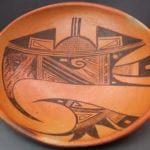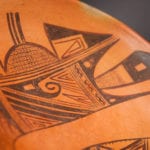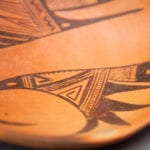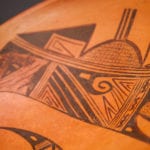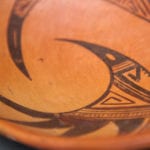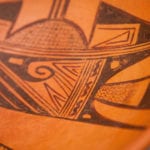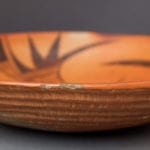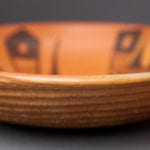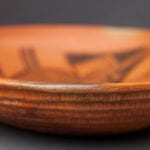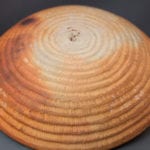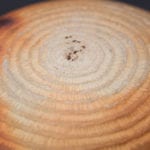This bowl appeals to me because of the humorous depiction of what I see as a baby bird playing with its mother. Forming clay bowls in baskets is an ancient practice, but except for this bowl and one other (2009-24) all other basket-impressed bowls in the collection are unpainted. (See Utility Post in Category List.) Both of the painted bowls were formed in 16-coil baskets, though of different depths.
The form of the bowl is almost perfectly round, with thick, even walls. The unslipped exterior shows marked color variation indicating where the heat of the firing was particularly hot or cooler. Three burn marks show where the fire touched the clay. There appear to be fragments of lettering on the bottom, but it is not possible discern a maker’s mark or name.
While polychromatic, the red paint is so dark red and sparsely applied that at a quick glance the design looks monochromatic.
The larger (“Mother”) bird is quite elaborately drawn. Along her back is a vertical gap containing two vertical lines, thus forming a three-lane “highway.” To the right is a large half circle containing a crosshatch grid of seven rows and sixteen columns, each resulting square enclosing a dot. Such a pattern is sometimes thought to signify a corncob. Emerging from the apex are three straight lines, perhaps corn tassels, to continue the analogy. Flanking this motif are two right-angle triangles (perhaps representing wings) with unpainted cores. These unpainted squares contain squared-off spirals, the top moving in a counterclockwise direction, the bottom counterclockwise. The external border of this rear section is outlined in red and red is also used to draw the squared-off spirals.
The design of the left side of the mother’s avian body is perhaps too complex to visualize with words. Sufficient to say that the head is large and detailed with a triangular eye, spackled cheeks, and a distinct black beak with a slight gap indicating upper and lower segments. Streaks of red also mark her cheeks. From shoulder to bellybutton run three large black stripes; above and below are collections of triangular shapes, also drawn in red. Amid all this angularity is a large black, curved wave-like element.
Another three-lane highway motif separates this upper core from the tail. Below are three squiggles, the center one painted red. The tail is composed of two forms. Rising from an (almost) solid black base two black points emerge toward the rear. The large open space between these points forms an arch with its interior border outlined in red. Emerging from the apex of the arch is a single broad black feather. The core of this feather is left almost unpainted, with the upper three-quarters speckled and the lower quarter blank. Following this is a large black pointed section with only a small central square unpainted.
The smaller “baby” bird is more simply composed, but is still complex. The head is a simple black sickle with an unpainted oval for an eye. Below is the familiar three-lane highway. Like momma, the baby has a body bisected by three black stripes by here the direction is reversed: front to back. A short back squared-off spiral lies directly behind the neck; a longer red squared spiral occupies the belly. A gap forming a three-lane highway lies below this body core, the lower lane filled with 25 tiny red dots. A red mound (echoing the corn mound on the mother bird) is based on the front edge of the highway.
The curve of the beak continues around to form a long, graceful pointed black arch; below this are three stubbier solid black arches, the first two emerging from the red mound. These arches are abstracted wings. Finally to the rear of these wing motifs is a large tail feather with the same layout as the mother except that here the open space in the tail is entirely speckled.
Such detail of design is difficult to follow verbally, but a reader persistent enough to have tried will notice many similarities of design elements and layout between the two birds. It seems probable that we are viewing depictions of mature and immature birds of the same species.
The design on bowl 2016-08 is done with great intentionality and care. The curves of the two beaks complement each other and a palpable visual tension flows between them. Some of this same playful, loving interaction is seen between mother and children on the 5-humingbird bowl by Nampeyo (2012-25).
Bowl 2016-08 is great folk art.
Almost all of the design elements found on bowl 2016-08 were used in ancient times at Hopi. See especially Watson Smith’s analysis of pottery designs from the ancient Hopi village of Awatovi (1971, pp 74 -178).


